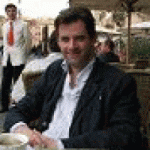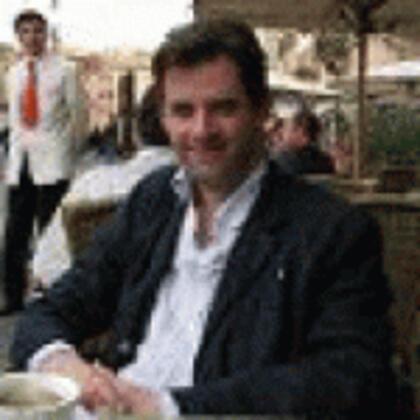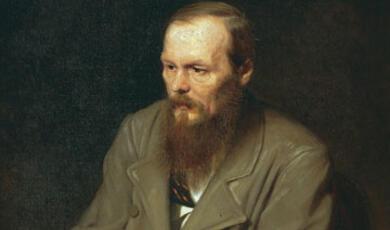30 March 2012
The ‘Desublimation’ of Modern Art:
A Theological Task?
Professor Ben Quash
It’s sometimes worth stating the obvious. We can’t live without it. We are extended, corporeal beings. Even imagining a world without space usually involves spatial assumptions or metaphors creeping back in. And anyway, space was part of God’s good creation, and God in Christ came to share it with us, so it has a certain hallowed quality.
In what follows, I am indebted to the original work of one of my PhD students, Chloe Reddaway, who is working on how space functions in and around Florentine Renaissance fresco cycles.
Walter Brueggemann writes,
“Place is space which has historical meanings, where some things have happened which are now remembered and which provide continuity and identity across generations. Place is space in which important words have been spoken which have established identity, defined vocation and envisioned destiny. Place is space in which vows have been exchanged, promises have been made, and demands have been issued.”[1]
Gardens, mountains, seas, deserts, promised lands, foreign cities: you can’t tell the story of God and his people without these… (Places you are sent to; places you want to get to but can’t, places you’re in but want to get out of; places where God surprises you because you didn’t expect him to be there, places where God promises to dwell so that you do expect him to be there…)
There is, of course, a tension going on too in the OT between place and not place. The Temple precipitates that. Brueggeman also suggests a loss of divine dynamism is associated with the building of the Temple.
In the Gospels, the importance of place is less easy to define. Events certainly take place in named locations and sometimes in significant ones, such as the Temple, but there is also a valid case for saying that place becomes less significant because Christ’s holiness transcends the holiness of place. It may be argued that for Christians there is no distinction between sacred and profane since all is God’s creation and since the “universality of the single divine power implied by monotheism makes nonsense of the notion that any place is the site of a special divine activity”.[2]
I now want to summarise what are going to be my main claims in this paper, and they have to do with how something has gone wrong since the medieval and Renaissance eras I just referred to. This something is closely bound up in the shifts in philosophical thinking both about religion and about aesthetics that are going on in the seventeenth century, and they have a profound effect on the way that we moderns relate to space.
To put it very baldly indeed, a sort of warfare is introduced between human beings and the spaces that they inhabit. The world becomes constructed as a place in which human beings are no longer at home. A Christian celebration of space as infused with God’s goodness and activity, and as our God-given natural milieu, loses it purchase on the modern imagination. It seems that there can only be two outcomes. In one, we win over space. In another, space wins over us. The arts play their part in endorsing and reinforcing this depressing outlook, by accepting a new opposition between the beautiful and the sublime, in which the latter is exalted as profound but dangerous, and the former as pleasing but superficial. The sublime is considered the more real; the beautiful a comforting illusion. The sublime is space running riot, so that the human form is minimized or obliterated by it. The sublime gestures to a space we cannot contain. The beautiful seems trivial as a consequence.
I am being very broad brush about this, but I want the claim to be vivid. I am going to illustrate it a little before ending with some suggestions of how a Christian tradition of art can and should be looked to for a more mediated, affirmative vision of we and the spaces we live in are related to one another and should relate to one another under God – while preserving one important thing that the sublime does, in its way, keep in play, which is to say the radical otherness and transcendence of God. My point will simply be that God’s transcendence can be safeguarded and honoured without a necessary opposition being set up with significant form, the human scale, and even the idea of beauty.
We’ve got to get space before it gets us!
As so often Kant crystallizes the problem. There are two aspects of his legacy that I want to highlight here. First, he opposes the infinite to the finite, with the correlate that the sublime (which is the art of infinity) is made the opposite of the beautiful (which is the art of proportion and finitude), rather than being seen as a compatible aesthetic partner to it [Burke did his own version of this already.] But second, he celebrates the power of human reason to stand above this opposition, retaining a sort of mastery even of sublime experience. The viewer of sublime spectacle, if strong enough in his or her reason, comes away with a strengthened view of the powers of the rational mind, and can display this mastery in works of art that show infinite sublime space being subjected to rational oversight.
For Kant, one’s inability to grasp the enormity of a sublime event such as an earthquake demonstrates the inadequacy of one’s sensibility and imagination. Simultaneously, one’s ability to subsequently identify such an event as singular and whole indicates the superiority of one’s cognitive, supersensible powers. A sublime object can thus create in us a fearfulness ‘without [our] being afraid of it’ (§ 28). For Kant, the sublime thus reveals our superiority over nature; it displays our mind’s power over sense; it enables us to appreciate our autonomy; we simultaneously see our physical selves as subject to the overwhelming power of nature and our rational selves as independent of it.
Two contradictory tendencies are thus displayed. In one direction nature’s awe threatens to overwhelm us. In the other direction the transformation of fear into delight seems to reveal our autonomous superiority.
Kant may have thought he had found a way to keep these two contradictory tendencies in play simultaneously, but in practice they have tended to fuel the view that if we don’t master sublime space first, it will conquer us. Artistic efforts in the first direction are largely classicizing and ‘rationalist’ (Nietzsche would have called them ‘Apollonian’). Artistic efforts in the other direction are what Nietzsche would call Dionysian, and the spirit of contemporary art, it is worth noting in passing, is predominantly a Dionysian one.
Dan Hardy delivered a lecture at the University of Virginia in 2004. He had stood, whilst there, at Thomas Jefferson’s “Rotunda,” which (as Peter Ochs points out) is the symbol of UVA and “the defining mark of Jefferson’s architecture for the school.”[3]If you stand there, at the northern head of the main campus, and look south over what is called “The Lawn,” you see elegant brick buildings to left and right. What you see straight ahead of you, once these apartment buildings stop, has undergone change since the campus was first designed and built. Originally, according to Jefferson’s vision, you would have seen an “unenclosed wilderness beyond.” Wild space. Sublime space. Now, the pressure for more facilities has caused the southern view to be closed off, so that instead of what Ochs calls the “open forests” you now see an auditorium and a large classroom building.
For Hardy there was something significant to be discerned about a rationalist imperative both in the original vision and in this later cut-off. It symbolized for him an important aspect of a rationalist understanding of the human being’s place in God’s creation. “For Jefferson”, he said, “reason is a human construct, informed by a priori principles inherent in our being or “nature.” This means that the other “nature” we find out there is ultimately unknown maybe even threatening... Nature is beautiful, to be sure, but also sublime and dangerous; it can be cognised only to the degree that it is domesticated, and it is domesticated only by human rationality.”[4]
Hardy went on to suggest that this initial way of thinking about nature as “other” already contained within itself the seeds of the next stage of architectural activity: the closing off of the south side so as to enclose “The Lawn.” Whatever the practical reasons may have been for doing it, this too (he felt) symbolized an ongoing failure of vision. Jefferson’s American enlightenment “standard of rationality”[5]could be read as reflecting a distrust of the unknowable in nature:
Nature is acceptable only when it accommodates our rational constructs. When nature displays its fury, we would judge it irrational and close it off, limiting reason’s gaze to what lies within our precincts.[6]
Whether or not it’s true of Virginia, it’s true of Versailles.
This is one half of the Kantian tension: we can prove ourselves independent of nature, and dominate wild spaces, by the exercise of our rational nature.
But the other side is that we feel ourselves – potentially – at the mercy of them.
The rise of the sublime parallels the event of modernity within philosophy, in which God and nature are likewise divorced, and set in mutually exclusive opposition to one another. Nature – the world of beings – is ‘transcended’ by God in a way that really means that God is absent from it: veiled and impenetrable. God’s transcendence can only now be understood, it seems, as God’s ‘exile beyond’ the world: “Occasionally breaking through perhaps, but only as an alienum...” (Hart 2003: 44) And postmodern thought in various ways continues to exalt the unrepresentable in direct continuity with this modern trajectory, as though the utterly unrepresentable is being at its truest and most untrammelled; being known precisely through its enmity towards ‘the fragile frozen present of representation’; known at the points when representation (whether conceptual or artistic) is ruptured or dissolved.
I loved seeing Raqib Shaw’s work with Tim Marlow recently, and think it’s truly extraordinary. ‘Beauty is the promise of happiness’, wrote Stendhal, and I find that sense of promise, but also of deferral, at work in what he makes. The art is vivid, immense, and full of an intensity that derives from its hovering between nostalgia for the past, hope for the future, and the ever-present fear that there at the root of life there is only entropy. Its longing for home is part of its beauty, and I like that. Its visual forms are a dance of connectedness, and I think that’s beautiful too. A lot of the connectedness – the way these forms participate in one another – is savage – very often taking the form of mutual consumption or sexual predation, and that’s part of how the works surprise us and make us think: are these the deepest forms of participation there are? Ought we to look for more? I didn’t find myself objecting to them in all the ways I expected to. In fact, what disturbed me more was not the intensive connections played out on the surface of these canvasses, but the way they seemed to float upon the surface of an infinite deep – like a sky or an ocean – that was magnificent but impassive. The forms that floated on the surface may have been violently or bestially connected, but at least they were connected. The one connection that wasn’t made was the connection between surface and depth, between beautiful form and sublime hinterland, between creation and creation’s source. If the surface patterns mean nothing, their formal beauty merely taunts or tortures us. It may be the only kind of beauty we feel we can honestly ‘own’ in our uncertain day, but it is a painful beauty – and I wonder whether it really merits the name.
I want here to quote the words of David Bentley Hart, in the hope that some of the issues I have begun to outline above reinforce his claim, as they echo his instincts:
“The thinking of surfaces subsists upon an aesthetics of the abyss, energy, boundless force, indeterminate instabilities that – through the violence of their ceaseless divergence and convergence within an untold depth of the indistinguishable – give rise to the evanescent shimmering of events and forms; the beautiful – conceived as a staid aesthetics of form, limit, boundary, hierarchy, harmony and accord – becomes simply another manifestation of the essentializing discourse of image and likeness and of the solace of metaphysics, while the sublime – conceived as the turbid immensity of the unrepresentable, a chaotic excess of indeterminacy, strife, incompatible difference, and inchoate energies – is raised up for affirmation. As a divine game of chance and fate, a game whose only rule is the necessity of the casting of the dice (and whose stakes are always the whole). From this sublimity beauty can be extracted, irrelevantly, only as a contraction and a concealment. Metaphysics, in its drive toward totality, classically conceives of the infinite as chaos or negation (or at best a ‘total’ synthesis), and certainly cannot conceive of an infinity that is offered peacefully – without alienation, negation, or deceit – as form.” (Hart 2003: 66-67)
A concern with the ‘spiritual’ and an expectation that this ‘spiritual’ reality will be found at the edges of life, in confrontation with world enigmas, or boundless space, is a dominant assumption in contemporary thought – and art. And such instincts are precisely not friendly to traditional theological ways of putting things. If we accept that sublime art is concerned aesthetically to evoke conceptual ideas of infinity in a distinctively modern vein, then we may conclude that it is not equipped to open any particularly privileged way to an appreciation of the divine glory, at least in traditional Christian terms. Like philosophy’s fascination with ‘alterity’, or phenomenology’s with ‘limit experiences’ of various kinds, we may say that the art of the sublime ‘will show itself inadequate for approaching the question of the transcendence of God’ (68).
And yet, Christians claim, God can be apprehended in some way in the midst of creaturely reality. It just won’t be this way: the way of sublime, narrowly or exclusively conceived as the ‘not-beautiful’. So what alternative is there – if any? The answer would, I think, be a surprising one, and perhaps an unwelcome one, to many moderns. It is the incarnational turn to the body – and with it to the particularity of persons - that opens for a Christian tradition of art its best possible chance at transcendence.
The body cannot ever leave centre stage for a Christian art. Or at least, it must be implied or respected by Christian art, even if not visibly present in a particular picture [cf. Anna M.R. Freeman’s work.] The human speaks even through images that indirectly reference the body.
The art of the embodied Christ does not of course capture or describe God’s transcendence; rather, it relinquishes its desire to realize it as a human idea or image, and prepares itself to receive the unsettling intuition – in faith – that God is beyond any artificial border we may set up between what is interior to the world and what is exterior to it. There is nothing in relation to which God is ‘outside’ or ‘beyond’. ‘God is not contained within the created ‘there is’, nor is God in his transcendence comparable to anything created’ (70). And the ‘surpassingness’ of God’s transcendence is in no way the ‘surpassingness’ we sense when we feel the limits of our powers of sense perception and rational apprehension (our cognitive powers).
We need to reject the often attractive instinct that ‘if our sensible and rational powers were only greater, the transcendence by which God surpasses these capacities might then perhaps after all come into view through a magnification of the sensible or intellectual vision’ (74). These powers ‘are intrinsically objectifying and thus limiting (determining) powers, whereas God’s transcendent reality is not a determinate or even indeterminate cognitive ‘object’ of any kind’ (74).
And yet, to address ourselves to the body or the face or the words of Christ, as artists and writers have encouraged us to do in countless ways, is to do something different. ‘Ecce homo’ is their proper invitation to ask the question ‘Who are you?’ of Christ. As Dietrich Bonhoeffer has insisted, this is the only genuine way to approach the transcendence of God, rather than the transcendence of limit experiences or limit thoughts. Or, to put it another way, it is to encounter a limit at the centre of life, and not at its edges; one who resists our possessive appropriation, and yet is wholly embodied and real and historical. Bonhoeffer writes:
“Behold God become human, the unfathomable mystery of the love of God for the world. God loves human beings. God loves the world. Not an ideal human being but human beings as they are, not an ideal world, but the real world. What we find repulsive in their opposition to God, what we shrink back from with pain and hostility, namely, real human beings, the real world, this is for God the ground of unfathomable love. ... [It is] not enough to say that God embraces human beings ... [for] this affirmation rests on an infinitely deeper one ... [namely] that God, in the conception and birth of Jesus Christ, has taken on humanity bodily...”
The “shock and awe” tactics celebrated by their perpetrators in the Iraq invasion were not simply aimed at the defeat of a spent regime, but rather at a global public gaze, a display of overwhelming power the immediate target of which was not just the high-density population of the city, but the Middle East as a political region and the global population as a whole.
‘The strategy of “shock and awe” was devised by its strategists in the Pentagon as one based on the assumption that the unleashing of firepower so overwhelming in its intensity and frequency would compel the enemy into almost immediate surrender. Punishment had to be performed in excess and such excess had to be turned into a form of spectacle, to generate awe in those witnessing the performance of sovereign power that was, in the act, reconstituted as triumphant power. But when war is spectacle, experience and its materiality in the body are somehow occluded…’
But there is a sense in which art can desublimate, enabling resistance to that which seeks to produce awe.
Vivienne Jabri was interesting, because she issued a call for a return to the body. But for her this is premised upon an insurmountable opposition between the idea of the sublime and the fragile fact of the human body. They cannot for her be reconciled in the same space. The totalizing, universalizing pretensions of the sublime must always in the end eclipse or crush the human form, and the depiction of human-scale things – the body and its suffering above all – are to be understood as a necessary act of resistance to the sublime. A necessary de-sublimation of its excesses, especially when harnessed by those ambitions to wield absolute power.
An ancient Christian tradition thinks that glory and the human form are quite compatible.
Here is Hart again:
“A Christian understanding of affirmation... entirely reverses the logic of the modern or postmodern sublime, by proceeding from a theological account of beauty: a beauty in which a truer sublime (the inexhaustible glory of being) is contained.” (Hart 2003: 72)
This set of Christian commitments has manifested itself in what I would call a ‘habitable’ art which nonetheless remains an art of the divine transcendence.
The beautiful is not trivial. Habitability is not a despicable concern.
And the body is central to it – although so is the space around and between bodies.
The question with which the modern stand-off so sharply leaves us is whether ‘the distance between selves’ can be a distance ‘without negation, privation, or strife’ (Hart), and therefore also a distance capable of pervading and binding being. Can finite difference be shown by a sufficiently rich notion of beauty ‘to belong – before all else – to an infinite display of blessings at peace with one another, whose intervals are places of aesthetic mediation in which difference may be shared under the aspect of gift’? (Hart 2003: 90) That is a challenge to Christian theology as much as a question to the disciples of an impersonal, dark sublimity.
My argument has been that fundamental to a Christian treatment of space in art is the experience – and the expectation - of ‘communion’; of a mysterious sharing and bonding between created things. This is participatory beauty – the beauty of things connected, relating, displaying their ‘at-homeness’ with each other, all sharing in a hymn of praise in which there is both light and shadow; abstraction and figuration; depth and surface. Each particular thing in our environment can be wonderfully individuated - but also fully related to the others. And their being fully individual-and-related in this way can be acknowledge in acts of aesthetic unification which refer them all to God, their deep source. The ‘deep’ here is a good ‘deep’; a trustworthy ‘deep’, a ‘deep’ that loves the individual forms whose being it supports, and that wants to preserve such forms in all their diversity within the generous space that it has provided for them.
© Ben Quash 2012
[1]Brueggemann.Quoted in Inge.p.36
[2]J. and North P. North, ed. Sacred Space : House of God, Gate of Heaven (London: New York, 2007).p.5.
[3]Ochs, Another Reformation,169.
[4]Ochs, Another Reformation,170.
[5]Ochs, Another Reformation, 170.
[6]Ochs, Another Reformation, 170.


 Login
Login







